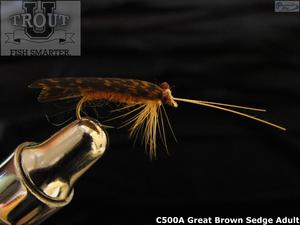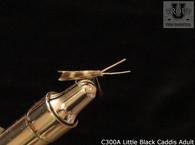
There are caddisflies that are commonly called “fall caddis flies” since they do in fact hatch in the fall. Another non descriptive name for these caddisflies is October Caddis. The insects called by those names as well, as other names, are members of the Limnephilidae family of caddisflies. These caddisflies are often called the "tube-case caddis" because all of the different species within the family have tube shaped, cases made of sticks, small pebbles, or other material found on the bottom of the stream. Within this outer covering of sticks and stones lies a tiny layer of silk.
We at the Troutprostore have fly patterns that imitate the pupa and adult stages of the two major species of caddisflies and they are the October Caddis and the Great Autumn Brown Sedge. The October Caddis, Dicosmoecus species can be found somewhat in the eastern states but far more are found in the western states, while the the Great Autumn Brown Sedge Psycnopsyche species, are found in the Eastern and Mid-western states. The Great Autumn Brown sedge is often called the Giant Orange Sedge because it has a somewhat orange color. However, the October Caddis has a more yellowish tint to their appearance.
The trout do eat the adults of the western October caddis species, rather well during much of the daylight; however, it isn't necessarily true of the Great Autumn Brown Sedge, which usually deposit their eggs very late in the afternoon and early evenings. Therefore, fishing with dry flies imitating the adult can be fun at certain times of the day. However, it may not be as much fun to fish with the pupa imitations, but you will net more trout using the pupa. They make an easy and somewhat large morsel for the trout as are accenting from the bottom to the surface of the stream to emerge and fly away.
When you go fishing this fall, be sure to supply your fly box with the Perfect Fly imitations of both stages of the October Caddis and the Great Autumn Brown Sedge from the Troutprostore.






